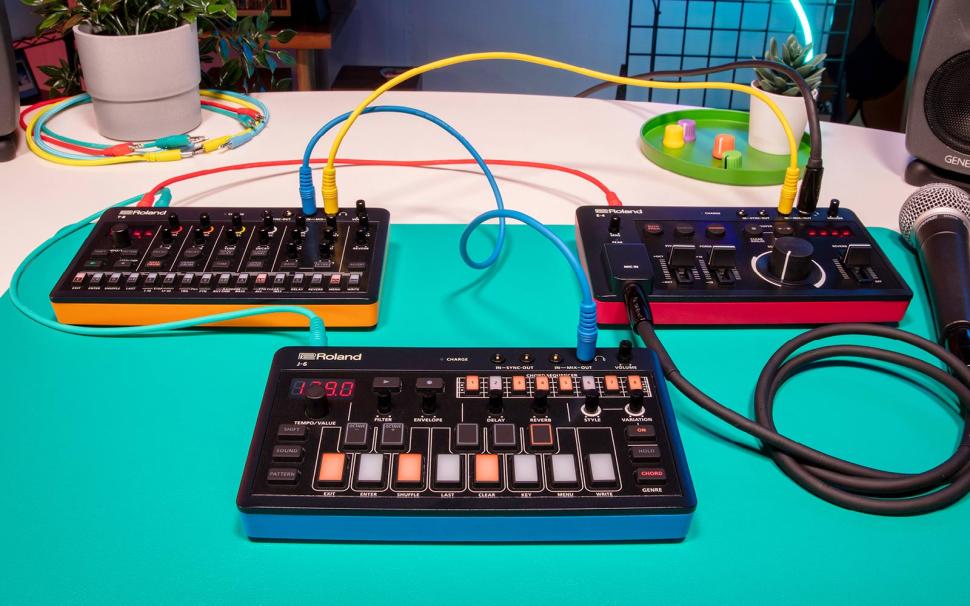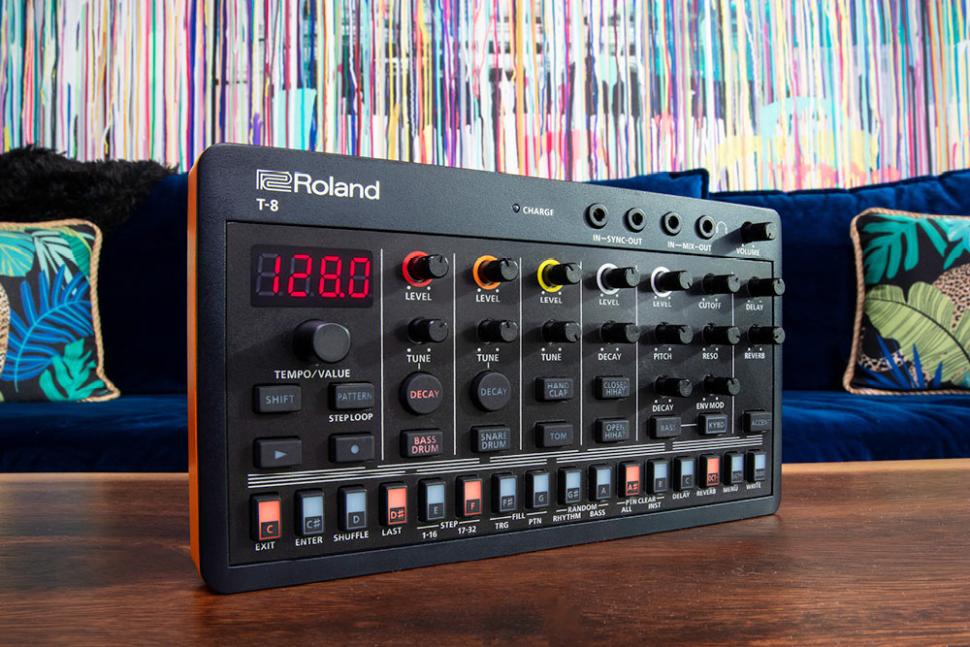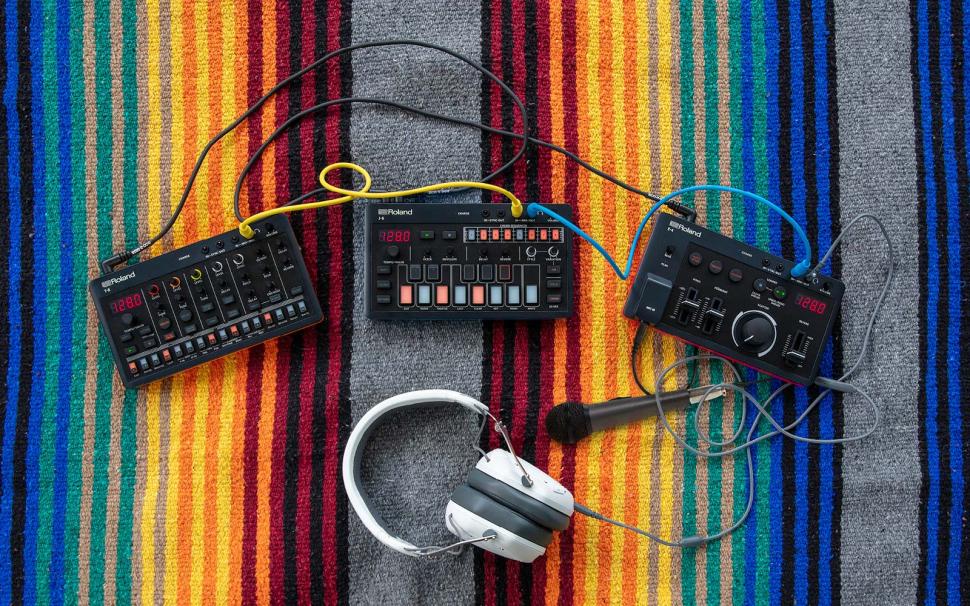Test: Roland AIRA Compact

The AIRA Compact series starts with three different instruments that are meant to complement each other: T-8 is a small groovebox and combines a TR drum computer with a TB-303-inspired bass synthesizer along with a matching sequencer. J-6 is a Juno-60 inspired four-voice polyphonic synthesizer with various chord sets and arpeggios for interesting harmonies and melodies. The E-4 Voice Tweaker, which offers a variety of effects from vocoder to harmonizer and from looper to a scatter for rhythmic chopping of the input signal, is the final feature.
Ultra compact
All three devices have the identical dimensions of approximately 19 x 11 x 4 cm and are, therefore, about as wide as the Korg Volcas, but slightly less deep. The display is a 7-segment display, so only numbers like tempo and preset number, as well as simple strings can be displayed. Like the Volcas or Roland‘s Boutique series, all three devices have a 3.5mm mini-jack headphone jack for an audio output, placed in the upper right corner next to the small volume control.
USB-C for MIDI/Audio
Alternatively, the audio signal can also be tapped digitally via the USB-C port and integrated losslessly into the DAW. This compact device functions as an audio interface and can also be supplied with power via USB. The latter can be deactivated to conserve the battery of the connected mobile device, such as iPad or iPhone, and to avoid error messages due to excessive power consumption. In this case, the Roland synthesizer receives power from its built-in battery. The USB port is also compatible with Roland‘s AIRA MX-1 mixer.
Audio inputs
An external sound generator can be looped in via the mix input. Its audio signal is passed unprocessed to the output, so the input is primarily used to listen to the three devices together without an additional mixer or to add playback from a mobile device without further cabling. The E-4 has an additional jack input for a dynamic microphone to loop your own voice into the effect. In addition, the output of the E-4 is designed so that the microphone of a TRRS-connected headset can be used directly - good thinking! With a suitable adapter, this input can also be used as a monophonic line input to process other sound generators with the effects of the E-4, such as the rhythmic scatter function.
The E-4 has an additional jack input for a dynamic microphone to loop your own voice into the effect. In addition, the output of the E-4 is designed so that the microphone of a TRRS-connected headset can be used directly - good thinking! With a suitable adapter, this input can also be used as a monophonic line input to process other sound generators with the effects of the E-4, such as the rhythmic scatter function.
Groovebox T-8
The T-8 is a small groovebox, the mixture of a TR drum computer and a TB-303 bassline synthesizer probably reminds older generations at first sight of the legendary Rebirth software. As with all AIRA devices, the sound generation is completely digital. Roland relies on the proven ACB technology, which promises the most faithful reproduction of the analog circuits.

The six drum parts are a mix of the classic TR drum machines TR-909, TR-808 and TR-606. The kick comes from the TR-909 and can be changed directly in pitch and decay time with a small control, the attack can also be adjusted via the menu. The snare, on the other hand, sounds like TR-606. Besides tune and decay, you can also make the sound snappier via the menu by increasing the noise content. Handclap and tom share the level and tuning controls, but can be adjusted and programmed separately. Two different tom sounds are available in the menu and, instead of the 808 clap, you can select a NoiseTom or a classic TR-606 hightom for the clap channel. The last two tracks are reserved for the open and closed hi-hat, which also recreates a classic analog sound.
The six drum instruments can be programmed via the 16 pads in classic TR-X0X style. The pads are, unfortunately, not velocity sensitive, but accents can be set per step for variations in volume. Likewise, the probability for each step can be set, as well as a fast trigger repetition (ratchet) for short fills. A sequence has a maximum length of 32 steps, 64 different patterns can be stored in the memory of the T-8.
TB-303 Bassline
The bass synthesizer is modeled after the TB-303. An oscillator generates either sawtooth or square wave and travels through a low-pass filter that chirps and whistles in the usual manner at higher resonance. The envelope is limited to decay and is adjustable in intensity. The programming of a sequence works similarly to the drums, so not as complicated as a real TB-303 or the faithful replicas. Steps are set by clicking on the respective pad in the chaser and can then be changed in pitch and provided with accent and slide.
Instead of a step input, both drums and bass line can alternatively be played in real time and made to groove with swing and shuffle. Performance functions such as Step Loop, Mute, Fill, Reload and Pattern Shift provide further loosening of the patterns if required.
For further processing, the T-8 has reverb and delay, which are designed as send effects. You can, therefore, individually set for each drum part whether it is affected by reverb or delay. Dry bass drum, reverberated snare, and hi-hats with delay are therefore no problem. Unfortunately, the T-8 has no motion record, neither sound nor effect parameters can be recorded in the sequence - this is a pity, because this would have been technically feasible with little effort for a purely digital sound generator.
Like the large TR-8, the T-8 also has an internal sidechain effect, for example, to make the bass line quieter whenever the bass drum is playing. Reverb and Delay can also be lowered accordingly, which opens up creative possibilities for use. Unfortunately, the mix input does not run through the sidechain effect, this would have been another nice option for external sound generators. Under the hood and only accessible via menu, there is also an overdrive effect to make the kick thicker and more aggressive or to distort the 303 bass for classic acid sequences.
Many functions, familiar sound
So, there is a lot under the hood in this small groovebox compared to the direct competition. It is commendable that Roland has packed drums and bassline together in one device. In terms of sound, however, you‘re pretty much stuck with the classic Techno/Acid/Minimal sound, with relatively narrow specifications in terms of drum and bass sounds. If you don‘t like the composition of the classic TR sounds or the sound of the TB-303, you won‘t be happy with the T-8. But if you like this sound, you get a nice little groovebox with an assertive sound, direct operation of the most important functions and additional flexibility when using the shift functions, which then needs some practice due to the lack of labeling and proper display. The latter point of criticism, unfortunately, also applies to the other two compact devices. Competition for the T-8 comes mainly from Roland itself, the Zen Core-based compact groovebox TR-6S offers a much more comprehensive and varied sound package for 200 Euro more.

Poly-Synthesizer J-6
While the T-8 Groovebox is relatively conventional, Roland presents an innovative new concept with the J-6. This polyphonic synthesizer offers ACB-typical four voices, the sound generation is based on the legendary Juno-60 and, in this respect, corresponds to the JU-06a from the same company. The difference to its bigger brother from the Boutique series is that the sounds of the J-6 cannot be programmed from scratch. There are only 64 different presets to choose from, which can be adjusted via two macro controls. The Filter knob controls the frequency of the low-pass filter; with Envelope, can you adjust Decay and Release. Holding down the Shift key gives you additional access to the resonance and attack of the sound. Whether this affects the amp envelope or the filter envelope, or even both, depends on the preset; however, since the parameters of the Juno are relatively clear anyway and the presets offer a good average of the best known and most popular Juno sounds (often including the legendary stereo chorus), we found the limitations in practice to be less serious than expected.
Composition aids
The sounds are really brought to life by two additional features that were previously only found in this form in large and expensive workstations. On the one hand, the J-6 has a hundred different chord sets integrated, each containing twelve chords that are tuned to each other. And these chords can be set in motion with the built-in arpeggiator, with over a hundred variations available.
These chords and the arpeggios and phrases created from them can be played into the chord sequencer over several bars. A pattern can be up to 64 steps long, 64 patterns can be stored. The result can also be output via MIDI and recorded to the DAW, so you can also use it to control external hardware synthesizers or plug-ins and, therefore, bypass the limitations of the J-6‘s built-in sound generation.
Effects and Dynamics
Like the T-8, the J-6 also has a built-in Reverb and a Delay, whose intensity and time can be individually controlled. You can play the synthesizer with the 12 pads, which are arranged like a keyboard. Unfortunately, the pads are not velocity sensitive, but the sounds can be played dynamically using an external keyboard; and some arpeggio patterns even output different velocity values/accents for more lively patterns. In Chord mode, you trigger the 12 chords of the selected set using the pads.
With the arpeggiator, the played chords can be broken up and combined into new patterns. There are 9 styles with 12 variations each available. In addition to classic arpeggios with different tempos and playing directions, there are also more complex rhythms including strumming. Each step of the chord sequencer records not only the chord, but also the respective arpeggio, so that melody and rhythm can vary within the sequence. The recording can be done step-by-step or in real time.
Compact idea generator
Such a comprehensive composing aid in an ultra-compact format is a real novelty and makes the J-6 a real recommendation for almost all music styles! And on top of that, you get the very good sounding Juno emulation for under 200 Euro. The only thing we missed was the option to create your own chord sets - but usually you should be able to find a suitable progression for the hundred built-in sets consisting of 12 chords each, and you can also record your own chords for each sequencer step.
Vocal Effect E-4
The third device in the series is designed as an effects unit and is primarily intended for vocals, for example, to create additional harmonies, background voices or vocoder effects. The rhythmic stutter effect, however, is also well suited for chopping up drums, loops and pad sounds. Also with the E-4, the mix input is routed unprocessed to the output; for processing the audio signal, one of the three other options must be used: Microphone jack input on the front, headphone output with splitter adapter or headset, or the digital input via USB.
Autotune, harmonizer & vocoder
E-4 can take over different functions. Autocorrection of the pitch, that is, quasi-autotune in real time - either subtly or exaggerated artificially as an audible effect (autotune/autopitch). Likewise, a pitch change by one or more semitones is possible, in parallel you can adjust the formants: from woman to man, from Darth Vader to Mickey Mouse and vice versa. E-4 can also be used as a harmonizer by adding copies of your own voice in harmonically matching intervals. Suitable presets with different harmonies are available, and the key can also be adjusted as needed. Using an external keyboard, you can even play matching chords and harmonies in real time, so you don‘t have to rely on the 10 presets provided. This is especially interesting in combination with the chord sets of the J-6, which are also output via MIDI.
Vocoder
As a further effect, the pitch can be set to one note for unnatural robot voices, but classic vocoder sounds are also possible. For the vocoder, different waveforms like sawtooth, square or noise as carrier are available. Vocoder and jarmonizer can also be used simultaneously! The integrated noise gate and high-pass filter are helpful for vocal applications to clean up the input signal before processing.
Sound-wise, there is nothing to complain about, the autotune and harmonize functions are more than sufficient for live performance or as an effect, and the vocoder impresses with transparency and speech intelligibility. The section is operated via two faders, which can operate further parameters using Shift. As with the multiple assigned controls of T-8 and J-6, we missed a pickup function to avoid value jumps when switching parameters, this can hopefully be retrofitted via update.
Integrated Looper & Scatter
But autopitch, harmonizer and vocoder are only a part of the possibilities, because E-4 can also be used as a looper. The recorded phrase can be up to 24 seconds long, the looper offers unlimited overdubbing, UNDO/REDO and automatic tempo/BPM detection. The loop can then be processed with the Scatter effect already familiar from other AIRA devices.
The large rotary control can be used to call up a number of variations that process the audio signal in different rhythms and intensities in terms of volume, panning, filter, playback direction, resolution and pitch, thus creating new grooves and sequences. This is interesting not only for voices, but also for all other sounds and tones. Three slots with ten variations each can be selected with the knob, and each slot can be assigned to one of the 19 integrated scatter sets. Other effects in the E-4 include reverb, echo, delay and chorus, each with a customizable parameter; however, these effects are only available alternatively and cannot be used simultaneously.
VERDICT
We were a bit surprised when Roland presented the new AIRA Compact series without much notice. After all, the market for ultra-mobile, inexpensive sound generators already seems very saturated and, at first glance, the three devices also seem to have little new to offer. In practice, however, this is actually only true for the T-8. The small groovebox really has a lot of functions packed into the compact format, but the hardware Rebirth with a combination of TR drums and TB bassline offers little new in terms of sound. The T-8 is primarily interesting for friends of classic Acid/Techno/Minimal, whereas purists will be happier with the analog replicas from Behringer or Korg.
The polyphonic Juno emulation sounds fresh and assertive, but the highlight is the combination of chord sets and phrase arpeggiator, along with the matching chord sequencer as an intuitive idea generator and compositional aid. The E-4 effects unit is no less innovative because, in addition to classic voice effects such as autotune, harmonizer and vocoder, you also get a looper and a creative chopper in pocket format.
In addition to direct operation of the essential parameters, assertive HiFi sound and uncomplicated linking, all three AIRAs score with built-in rechargeable battery and audio interface for mobile use.
Want more? Get more!



Subscribe to the digital edition of BEAT Magazine via Plugins-Samples.com and get more gear, in-depth workshops, reviews and 11 GB exclusive plugins and new sounds with every monthly issue!
Subscribe to Beat Magazine for only 4.99€ per month
